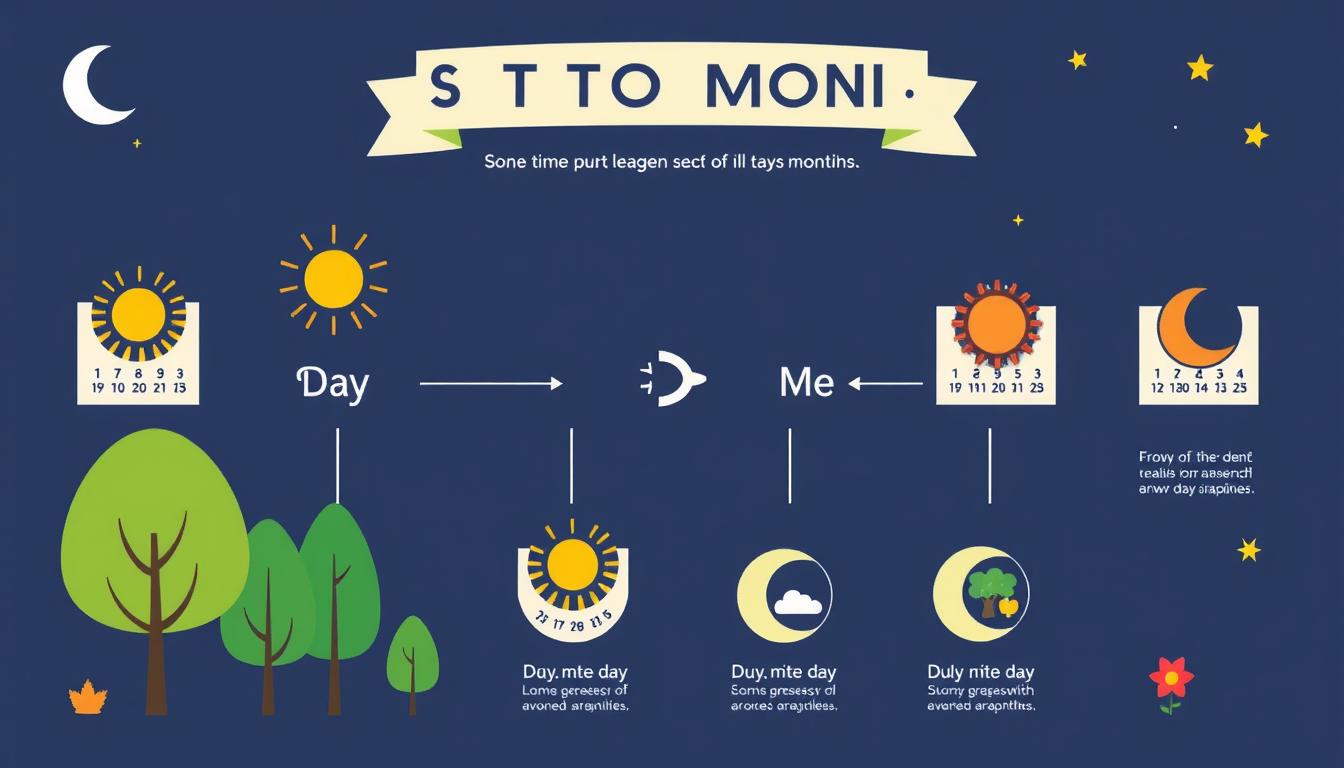A sleek and modern digital interface displays a day-to-month conversion calculator. It features a minimalist design with vibrant colours, abstract geometric shapes in the background, and animated icons representing time, such as clocks and calendars, creating a visually engaging and dynamic atmosphere.
Time conversion can be tricky. It helps with tracking projects and planning events.
Accurate time conversion is crucial for precise planning. It saves time and reduces errors in many areas.
A reliable method provides instant, accurate results. Modern tools make time measurement seamless and easy.
This guide shows how to convert days to months. You’ll learn standard rates and real-world uses.
These skills help manage time better. Let’s master changing days into months confidently.
Understanding Time Measurements
Time measurements help us track and organize our daily lives. Different calendar systems use unique methods to calculate days in a month.
The Gregorian calendar provides a structured approach to measuring time units. Most countries use this calendar today.
Months usually have 30 or 31 days, except February. This variation creates challenges when converting time between units.
Some calendars use lunar cycles, while others follow solar calculations. These differences affect how we perceive days in a month.
Time units reflect human cultural experiences. Our methods of tracking time have changed from sundials to digital clocks.
Professionals must understand calendar system differences. This knowledge is crucial in project management, astronomy, and international business.
Modern tech makes time conversions easier. However, knowing the basics is still essential.
Understanding time units helps people plan better. It bridges gaps between different measurement systems.
How to Convert Days to Months Easily
Converting days to months is simple. You need to know the formula and use the right tools.
Most calculations use an average month length of 30.44 days. This provides a standard for time conversion.
To convert, divide the total days by 30.44. For example, 90 days equals about 2.96 months.
Digital tools make this even easier. Websites and apps offer instant calculators for quick conversions.
Professional software often has built-in conversion features. These tools are excellent for precise time tracking.
Different situations may need different approaches. Always consider your specific needs when choosing a conversion method.

Common Conversion Scenarios
Day-to-month conversions are vital in many work and life situations. Project timelines need exact time tracking across different units.
Businesses use these calculations to manage workflows and resources. Billing cycles also rely on day-to-month conversions for accuracy.
Subscription periods often cover many months. Service providers need good ways to track agreements and billing times.
Software teams use these conversions for sprint plans and project goals, and digital platforms use them for smooth user experiences and billing.
Banks and insurance firms use conversions for contracts and loans. This helps avoid errors and keeps client talks clear.
Knowing how days become months also benefits personal finance. It helps one easily track investments, savings goals, and subscription renewals.
Real-Life Examples of Day-to-Month Conversions
A visually engaging infographic illustrating the conversion of days to months, featuring a calendar motif with various representations of days (like sun icons for days) transitioning into month symbols (like crescent moons or seasonal imagery), surrounded by natural elements like trees and stars, in a harmonious colour palette that emphasizes the passage of time.
Pregnancy tracking often uses day-to-month conversions. Parents need this for medical visits and planning.
Travel planners use these conversions for long trips. It helps with budgets, visas, and trip management.
Loan terms also use monthly calculations. This helps borrowers understand their repayment schedules better.
Day-to-month conversions are helpful in many situations. They provide clarity for making wise choices.
Tips for Accurate Time Conversion
Precise day-to-month conversions require careful attention to key factors. Leap years can impact time calculations, especially for periods spanning multiple years.
Rounding methods ensure more accurate results in time tracking. Time zones are crucial for maintaining conversion accuracy.
Always check specific time zone references for international dates. Different regions may have unique calendar variations affecting calculations.
Professional time conversion needs strategic rounding approaches. Standard methods include rounding to the nearest month or using exact day counts.
Scientific and financial applications require precise day calculations. Digital tools can help minimize errors in complex time conversions.
Always double-check your calculations, especially with complex periods. Software tools provide support, but manual verification ensures absolute accuracy.
FAQ
How many days are typically in a month?
Most months have about 30 days. This helps when changing days to months for general use.
Why do I need to convert days to months?
Changing days to months helps with many things. It’s useful for projects, bills, pregnancy, travel, and subscriptions.
What’s the simplest way to convert days to months?
Divide the total days by 30.44. This is the average day in a month.
For example, 90 days ÷ 30.44 = 2.96 months. This rounds to about 3 months.
Do leap years affect day-to-month conversions?
Leap years add one day to February. For most changes, using 30.44 days still works well.
Are online conversion tools accurate?
Online tools are usually correct. They use standard math for conversions.
For necessary money or legal math, double-check or ask an expert.
How do different calendar systems impact month conversions?
Some calendars have slightly different month lengths. The Gregorian calendar is used worldwide.
It has an average of 30.44 days per month.
Can I convert months back to days?
Yes! Multiply the number of months by 30.44. This gives you the days.
For example, 3 months × 30.44 = 91.32 days.
What should I consider when doing precise time conversions?
Think about why you need the conversion. Check if you need exact or rough numbers.
For important math, use special conversion tools or ask an expert.
You can also read more : The Legendary Tom Oar: A True Mountain Man



